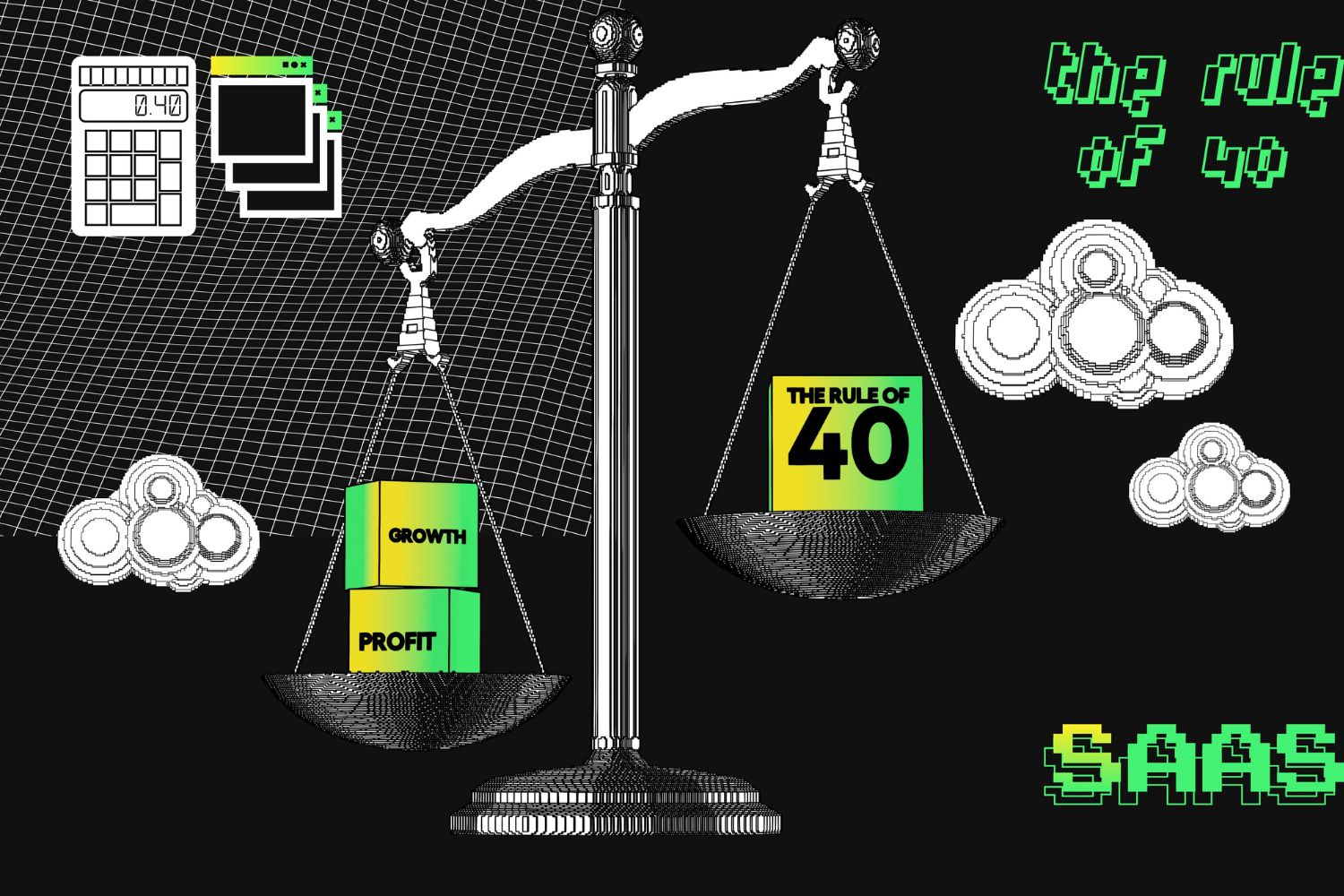Introduction
Welcome to the world of SaaS (Software as a Service) where growth and profitability are key metrics for success. In this highly competitive industry, it is crucial for companies to find effective ways to assess their financial performance and determine if they are on the right track. One popular method that has gained traction in recent years is the “Rule of 40.”
The Rule of 40 serves as a guiding principle for SaaS companies to evaluate the balance between revenue growth and profitability. It acknowledges that while driving revenue growth is important, it should not come at the expense of profitability. By striking a balance between the two, SaaS companies can ensure sustainable and long-term success.
In this article, we will delve into the Rule of 40, understand how it is calculated, and explore its benefits and limitations. We will also provide real-world examples to illustrate its practical application in the SaaS industry.
Whether you are a SaaS entrepreneur, an investor, or simply curious about the inner workings of the SaaS industry, this article will equip you with the knowledge and insights to navigate the Rule of 40 and make informed decisions.
What is the Rule of 40?
The Rule of 40 is a financial yardstick used in the SaaS industry to assess a company’s overall financial health. It provides a holistic view by considering both revenue growth and profitability. The rule states that for a SaaS company to be considered healthy, the combined percentage of revenue growth and profitability should be equal to or greater than 40%.
To calculate the Rule of 40, you simply add the company’s revenue growth rate and its profitability margin. For example, if a SaaS company has a revenue growth of 30% and a profitability margin of 15%, their Rule of 40 score would be 45% (30% + 15% = 45%). This indicates that the company is performing well and is in a strong position.
By using the Rule of 40 as a benchmark, SaaS companies can monitor their financial performance and ensure a healthy balance between growth and profitability. It offers a more comprehensive perspective compared to solely focusing on one aspect, such as revenue growth or profitability alone.
The Rule of 40 recognizes that excessively prioritizing revenue growth can lead to operational inefficiencies and unsustainable growth. On the other hand, overemphasizing profitability without sufficient revenue growth can hinder a company’s ability to scale and expand.
By aiming for a Rule of 40 score of 40% or higher, companies can strike a delicate balance between these two factors. It provides a guideline for decision-makers to evaluate whether their company’s growth is driven by healthy financial practices and sustainable strategies.
While the Rule of 40 is commonly used in the SaaS industry, it is not a foolproof metric. It should be used in conjunction with other financial and operational indicators to gain a comprehensive understanding of a company’s performance and prospects.
Now that we understand what the Rule of 40 entails, let’s explore how to calculate it in the next section.
How to Calculate the Rule of 40
Calculating the Rule of 40 is a straightforward process that involves determining the combined percentage of revenue growth and profitability. To calculate the Rule of 40, follow these steps:
- Calculate the revenue growth rate: Start by calculating the percentage increase in revenue over a specific period. This can be done by subtracting the previous period’s revenue from the current period’s revenue, dividing it by the previous period’s revenue, and multiplying by 100. For example, if a company’s revenue increased from $1 million to $1.5 million, the revenue growth rate would be 50%.
- Calculate the profitability margin: Next, calculate the profitability margin, which is the percentage of revenue that translates into profit. This can be calculated by dividing the company’s net profit by its total revenue and multiplying by 100. For example, if a company has a net profit of $500,000 and a total revenue of $1.5 million, the profitability margin would be 33.33%.
- Add the revenue growth rate and profitability margin: Finally, add the revenue growth rate and the profitability margin to obtain the Rule of 40 score. For example, if the revenue growth rate is 50% and the profitability margin is 33.33%, the Rule of 40 score would be 83.33%. This indicates a strong financial performance and a healthy balance between growth and profitability.
By calculating the Rule of 40, SaaS companies can evaluate their financial health and assess whether they are achieving a balanced growth trajectory. It serves as a practical tool for decision-makers to monitor their company’s performance and make data-driven decisions.
Now that we know how to calculate the Rule of 40, let’s explore the components that make up this metric in the next section.
Understanding the Components
The Rule of 40 combines two key components to assess a SaaS company’s financial health: revenue growth and profitability margin. Understanding these components is essential to effectively interpret and utilize the Rule of 40. Let’s take a closer look at each component:
- Revenue Growth: Revenue growth measures the rate at which a company’s revenue is increasing over time. It indicates the company’s ability to attract new customers, retain existing ones, and generate additional sales from upsells or cross-sells. Higher revenue growth suggests strong market demand and successful sales and marketing strategies.
- Profitability Margin: Profitability margin, also known as profit margin, is a measure of a company’s ability to generate profits from its revenue. It reveals how efficiently a company is managing its resources, controlling costs, and turning revenue into profit. A higher profitability margin indicates effective cost management and pricing strategies, contributing to sustainable financial performance.
When these components are combined in the Rule of 40 calculation, they provide a comprehensive view of a SaaS company’s performance. It ensures that companies are not solely focused on revenue growth at the expense of profitability or vice versa.
It’s important to note that the Rule of 40 does not prescribe specific targets for revenue growth and profitability margin individually. Instead, it emphasizes the need for a balanced approach, where the combined percentage of these components should equal or exceed 40%. This ensures that companies are not sacrificing long-term sustainability for short-term growth or profitability.
By understanding and evaluating the components of the Rule of 40, SaaS companies can gain insight into the overall health of their business. They can identify areas of strength and areas that require improvement, enabling them to make informed decisions and strategic adjustments.
Next, let’s explore the benefits and limitations of using the Rule of 40 in assessing a SaaS company’s performance.
Benefits of the Rule of 40
The Rule of 40 offers several benefits to SaaS companies and stakeholders in assessing financial performance. Here are some key advantages:
- Comprehensive Financial Assessment: The Rule of 40 takes into account both revenue growth and profitability, providing a more comprehensive evaluation of a company’s financial health. It ensures that companies are not solely focusing on one aspect while neglecting the other.
- Balanced Growth and Profitability: The Rule of 40 encourages a balanced approach to growth and profitability. It helps companies avoid unsustainable practices, such as excessively sacrificing profitability for top-line revenue growth or vice versa.
- Long-Term Sustainability: By aiming for a Rule of 40 score of 40% or higher, companies prioritize long-term sustainability. This metric encourages them to adopt strategies that will drive stable and profitable growth over time, rather than pursuing short-term gains at the expense of long-term viability.
- Industry Benchmark: The Rule of 40 serves as a benchmark for SaaS companies, enabling them to compare their financial performance against industry standards. It provides a common metric that is widely recognized and enables companies to gauge their competitiveness and positioning within the market.
- Investor Confidence: Investors often use the Rule of 40 as an important factor in evaluating potential investments in SaaS companies. A strong Rule of 40 score indicates a healthy financial position and can instill confidence in investors, attracting potential funding opportunities and partnerships.
The Rule of 40 is a valuable tool that helps SaaS companies strike a balance between growth and profitability, foster sustainable practices, and assess their financial well-being. By leveraging this metric, companies can make informed decisions, optimize their strategies, and position themselves for long-term success.
Now that we’ve explored the benefits of the Rule of 40, it’s important to acknowledge its limitations as well. Let’s dive into that in the next section.
Limitations of the Rule of 40
While the Rule of 40 provides a valuable framework for assessing financial health in the SaaS industry, it is important to consider its limitations. Here are some key limitations to keep in mind:
- Industry Specific: The Rule of 40 is primarily applicable to SaaS companies due to the unique nature of their business models. It may not be suitable or relevant for companies in other industries that have different growth and profitability dynamics.
- Varied Profitability Metrics: Different companies may use varying metrics to calculate profitability, such as EBITDA (Earnings Before Interest, Taxes, Depreciation, and Amortization) or net income margin. This can lead to inconsistencies in how the profitability component is measured and compared between companies.
- Timing and Short-Term Focus: The Rule of 40 is a snapshot metric that focuses on a specific point in time. It may not capture the long-term growth trajectory or the impact of future investments or strategic initiatives. Companies with short-term variations or those in a high-growth phase may not reflect a true picture of their overall financial health using this metric alone.
- Ignorance of Other Factors: The Rule of 40 does not take into account other crucial factors that contribute to a company’s success, such as customer acquisition costs, churn rate, or market dynamics. Relying solely on this metric without considering these factors may lead to an incomplete assessment of a company’s financial performance and potential risks.
- Generalization of Company Performance: Not all SaaS companies are the same, and their business models, markets, and growth strategies can differ significantly. Applying a single benchmark like the Rule of 40 to all companies may oversimplify the complexities and unique characteristics of individual organizations.
It is important to consider these limitations and supplement the Rule of 40 with other financial and operational metrics to gain a more comprehensive understanding of a SaaS company’s performance.
Now that we have explored the limitations of the Rule of 40, let’s dive into some real-world examples of its application in the next section.
Real-world Examples of the Rule of 40
To better understand the practical application of the Rule of 40, let’s explore a few real-world examples of SaaS companies and their corresponding Rule of 40 scores:
- Company A: Company A achieved a revenue growth rate of 30% and a profitability margin of 10%. Adding these two components together, their Rule of 40 score is 40%. This indicates that Company A is meeting the balanced growth and profitability threshold set by the Rule of 40.
- Company B: Company B experienced a rapid revenue growth rate of 70% but struggled to maintain profitability, with a margin of -5%. Consequently, their Rule of 40 score is 65% (70% + -5%). While Company B demonstrates strong revenue growth, their negative profitability margin indicates potential inefficiencies that need to be addressed.
- Company C: Company C achieved stellar profitability with a margin of 25%, but their revenue growth rate was relatively modest at 10%. As a result, their Rule of 40 score is 35% (10% + 25%). Although Company C has solid profitability, their lower revenue growth suggests opportunities for further expansion and market penetration.
- Company D: Company D exhibited exceptional performance, boasting a revenue growth rate of 75% and a profitability margin of 20%. This translates to a Rule of 40 score of 95%, indicating strong growth and profitability alignment. Company D is positioned favorably and demonstrates a healthy financial position.
These examples illustrate how the Rule of 40 can vary across different companies with distinct growth and profitability dynamics. Each score provides insights into the company’s financial performance and serves as a comparative benchmark against industry standards and competitors.
It’s essential to remember that Rule of 40 scores should not be analyzed in isolation. Additional factors such as market conditions, industry trends, and company-specific considerations must be taken into account to obtain a comprehensive view of a SaaS company’s overall health and potential for sustained success.
Now that we’ve explored real-world examples, let’s conclude our journey through the Rule of 40 in the next section.
Conclusion
The Rule of 40 serves as a valuable tool for SaaS companies and stakeholders to assess financial health and evaluate the balance between revenue growth and profitability. By aiming for a Rule of 40 score of 40% or higher, companies can prioritize long-term sustainability while driving growth.
Understanding the components of the Rule of 40, revenue growth, and profitability margin, is crucial in interpreting and utilizing this metric effectively. It provides a comprehensive view and ensures that companies are not overly focused on one aspect at the expense of the other.
While the Rule of 40 offers several benefits, such as providing a benchmark, encouraging a balanced approach, and attracting investor confidence, it also has limitations. It is important to consider other factors, industry specifics, and the timing of the assessment to gain a holistic understanding of a company’s financial performance.
Real-world examples have demonstrated how Rule of 40 scores can vary across different companies, emphasizing the importance of considering individual contexts and market dynamics. The Rule of 40 should be used alongside other metrics to make informed decisions and evaluate a company’s overall financial health.
In conclusion, the Rule of 40 serves as a valuable guide for SaaS companies seeking sustainable growth and profitability. By employing this metric appropriately, companies can navigate the competitive landscape, make strategic decisions, and position themselves for long-term success in the dynamic world of SaaS.

























